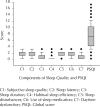Association between sleep quality and quality of life in nursing professionals working rotating shifts
- PMID: 25210818
- PMCID: PMC4181093
- DOI: 10.1590/s0034-8910.2014048004939
Association between sleep quality and quality of life in nursing professionals working rotating shifts
Abstract
Objective: To analyze the association between sleep quality and quality of life of nursing professionals according to their work schedules.
Methods: A prospective, cross-sectional, observational study was conducted between January and December 2010, with 264 nursing professionals, drawn from 989 subjects at Botucatu General Hospital and stratified by professional category. The Pittsburg Sleep Quality Index and the WHOQOL-bref were administered to evaluate sleep quality and quality of life, respectively. Self-reported demographic data were collected with a standard form. Continuous variables were reported as means and standard deviations, and categorical variables were expressed as proportions. Associations were evaluated using Spearman's correlation coefficient. The association of night-shift work and gender with sleep disturbance was evaluated by logistic regression analysis using a model adjusted for age and considering sleep disturbance the dependent variable. The level of significance was p < 0.05.
Results: Night-shift work was associated with severe worsening of at least one component of sleep quality in the model adjusted for age (OR = 1.91; 95%CI 1.04;3.50; p = 0.036). Female gender was associated with sleep disturbance (OR = 3.40; 95%CI 1.37;8.40; p = 0.008). Quality of life and quality of sleep were closely correlated (R = -0.56; p < 0.001).
Conclusions: Characteristics of the nursing profession affect sleep quality and quality of life, and these two variables are associated.
OBJETIVO: Analisar a associação entre a qualidade do sono e a qualidade de vida dos profissionais de enfermagem segundo organização do trabalho.
MÉTODOS: Estudo transversal, observacional e prospectivo, com 264 profissionais de enfermagem em Botucatu, SP, entre janeiro e dezembro de 2010. Os sujeitos foram sorteados entre os 989 indivíduos que trabalhavam no Hospital Geral de Botucatu e estratificados por categoria profissional. O Índice de Qualidade de Sono de Pittsburgh e o WHOQOL-bref foram aplicados para avaliar qualidade do sono e qualidade de vida, respectivamente. Os dados demográficos foram coletados por meio de formulário padrão. Variáveis contínuas foram apresentadas como média e desvio padrão e variáveis categóricas, como proporções. As associações foram avaliadas por meio do coeficiente de correlação de Spearman. As associações entre turno e sexo com a qualidade do sono foram analisadas por meio de regressão logística, no modelo corrigido para idade. Distúrbio do sono foi a variável dependente. O nível de significância adotado foi p < 0,05.
RESULTADOS: Trabalho noturno foi associado com prejuízo importante de pelo menos um componente da qualidade do sono (OR = 1,91; IC95% 1,04;3,50, p = 0,036). O prejuízo da qualidade do sono também se associou com o sexo feminino (OR = 3,40; IC95% 1,37;8,40; p = 0,008). Houve correlação estreita entre a qualidade de vida e qualidade do sono (r = -0,56, p < 0,001).
CONCLUSÕES: Características próprias da profissão de enfermagem podem afetar a qualidade do sono e a qualidade de vida, e essas duas variáveis estão associadas entre si.
Conflict of interest statement
The authors declare no conflict of interest.
Figures
Similar articles
-
Self-assessed quality of sleep, occupational health, working environment, illness experience and job satisfaction of female nurses working different combination of shifts.Scand J Caring Sci. 2006 Jun;20(2):229-37. doi: 10.1111/j.1471-6712.2006.00402.x. Scand J Caring Sci. 2006. PMID: 16756530
-
[Possibilities and limits of sleep recovery for night-nursing workers].Rev Gaucha Enferm. 2009 Mar;30(1):92-8. Rev Gaucha Enferm. 2009. PMID: 19653561 Portuguese.
-
Nursing work hours: individual needs versus working conditions.Rev Saude Publica. 2011 Dec;45(6):1117-26. doi: 10.1590/s0034-89102011000600014. Rev Saude Publica. 2011. PMID: 22124741 English, Portuguese.
-
Impacts of shift work on sleep and circadian rhythms.Pathol Biol (Paris). 2014 Oct;62(5):292-301. doi: 10.1016/j.patbio.2014.08.001. Epub 2014 Sep 20. Pathol Biol (Paris). 2014. PMID: 25246026 Review.
-
Health effects of internal rotation of shifts.Nurs Stand. 2000 Aug 9-15;14(47):34-6. doi: 10.7748/ns2000.08.14.47.34.c2895. Nurs Stand. 2000. PMID: 11974375 Review.
Cited by
-
Relationship between sleep quality and quality of life in patients with bipolar disorder.Sleep Sci. 2020 Jan-Mar;13(1):65-69. doi: 10.5935/1984-0063.20190135. Sleep Sci. 2020. PMID: 32670494 Free PMC article. Spanish.
-
Assessment of sleep quality and its factors among clinicians working in critical care units and operation theaters at North West Ethiopia, 2022: a multicenter cross-sectional study.Ann Med Surg (Lond). 2023 Jul 8;85(8):3870-3879. doi: 10.1097/MS9.0000000000001071. eCollection 2023 Aug. Ann Med Surg (Lond). 2023. PMID: 37554893 Free PMC article.
-
Effects of Day and Night Shifts on Stress, Anxiety, Quality of Life, and Oxidative Stress Parameters in Nurses.Florence Nightingale J Nurs. 2021 Feb 1;29(1):81-92. doi: 10.5152/FNJN.2021.19141. eCollection 2021 Feb. Florence Nightingale J Nurs. 2021. PMID: 34263226 Free PMC article.
-
Quality of Life of the Health Care Workers in the Pre-Retirement Period from the Private Sector of the Primary Health Care from the Skopje Region.Open Access Maced J Med Sci. 2015 Sep 15;3(3):514-20. doi: 10.3889/oamjms.2015.097. Epub 2015 Aug 31. Open Access Maced J Med Sci. 2015. PMID: 27275280 Free PMC article.
-
Serum testosterone/cortisol ratio in people with obstructive sleep apnea.J Clin Lab Anal. 2020 Jan;34(1):e23011. doi: 10.1002/jcla.23011. Epub 2019 Sep 23. J Clin Lab Anal. 2020. PMID: 31549459 Free PMC article.
References
-
- Admi H, Tzischinsky O, Epstein R, Herer P, Lavie P. Shift work in nursing: is it really a risk factor for nurses’ health and patients’ safety? Nurs Econ. 2008;26(4):250–257. - PubMed
-
- Braga LC, Carvalho LR, Binder MCP. Condições de trabalho e transtornos mentais comuns em trabalhadores da rede básica de saúde de Botucatu (SP) 10.1590/S1413-8123201000070007049891999001100007Cienc Saude Coletiva. 2010;15(Suppl 1):1585–1596. - PubMed
-
- Buysse DJ, Reynolds CF, 3rd, Monk TH, Berman SR, Kupfer DJ. The Pittsburg Sleep Quality Index: a new instrument for psychiatric practice and research. 10.1016/0165-1781(89)90047-4Psychiatry Res. 1989;28(2):193–213. - PubMed
MeSH terms
LinkOut - more resources
Full Text Sources
Other Literature Sources
Medical


